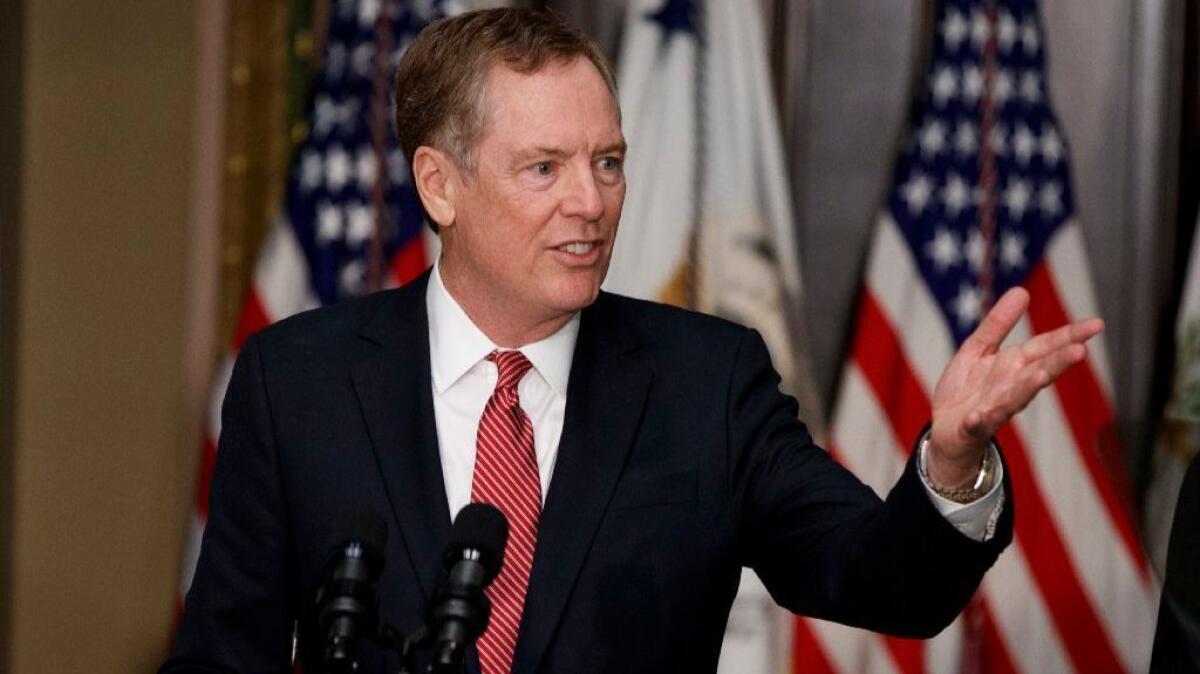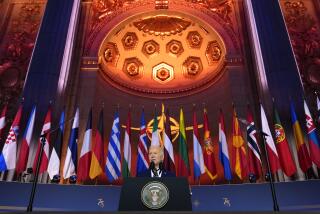After 3 days and 140 witnesses, public hearing on NAFTA hints at huge work ahead for U.S. negotiators

Reporting from Washington — As Washington events go these days, the hearing on the North American Free Trade Agreement was a snoozer: panel after panel of speakers reading five-minute-long statements, one after another, followed by a round of questions from a team of government bureaucrats.
Yet the three-day public session this week made clear the extensive and intensive interest in the Trump administration’s upcoming renegotiation of NAFTA.
Nearly 140 witnesses from the United States, Canada and Mexico appeared to give their opinions and suggestions, representing business, labor, think tanks, civil society, the powerful and the obscure.
Along with thousands of online public comments that crashed the U.S. Trade Representative’s website, the hearing overall provided a calm if somewhat dry forum in today’s politically charged atmosphere surrounding trade.
Although Trump has referred to NAFTA as “a disaster,” and in the spring came close to withdrawing from the agreement, hardly anybody spoke with such ferocity and even the title of the hearing — on “NAFTA Modernization” — suggested a more measured tone.
Still, sharp divisions — portending likely conflicts in the future for negotiators — were readily apparent. One point of contention had to do with the Trans-Pacific Partnership, President Obama’s free-trade agreement with 11 Pacific Rim countries that Trump canceled on his first day in the White House.
As much as Trump and his supporters have bashed that deal, more than a few stakeholders told the hearing that there was much good that could be borrowed from chapters in the Trans-Pacific Partnership, especially areas such as e-commerce, data flows and technical standards, which are largely absent in the 23-year-old NAFTA.
One panel that objected was organized labor, which repeatedly struck a note that the United States should steer away from using that agreement as a model.
“Merely tweaking around the edges and bringing in the TPP is inadequate,” said Thea Lee, an economist representing the AFL-CIO, addressing a team of six, mostly mid-level officials from the U.S. Trade Representative’s office and the departments of Commerce, Labor, Transportation and State.
The hearing was part of a congressionally required 90-day consultation period before the Trump administration can begin negotiations with its Canadian and Mexican counterparts. By that time frame, talks could start as early as mid-August. Both U.S. Trade Representative Robert Lighthizer and Commerce Secretary Wilbur Ross have spoken about their desire to complete the agreement by the end of the year. Neither was at the hearing.
But if the three days of testimony that concluded Thursday revealed anything, it was how wide-ranging and complicated the renegotiation will be, making it unlikely that it could be concluded within a few months.
Jeff Grove of ASTM International was part of a five-person panel, for example, that went into highly technical details about various international standards and measurements that he said needed to be developed and updated in NAFTA so American businesses aren’t left at a competitive disadvantage, especially in Mexico.
There were some 30 witnesses who took the mike to defend American farming interests, including several cattlemen and meat groups, tomato and strawberry growers from Florida, councils for cotton, milk and all sorts of grains.
“The hearing process is not only pretty indicative of the amount of interest but also the very deep, and the number of, issues out there,” Augustine Tantillo, president of the National Council of Textile Organizations, said after giving his testimony.
Tantillo, whose group represents companies that employ about 565,000 people in American textile and apparel, was the first presenter on the morning of Day One of the hearing, which didn’t end until 8 p.m. that night, with only one 15-minute break. Those monitoring the hearing said as many as 200 people filled the main hall at the International Trade Commission’s building.
Neither Tantillo nor anybody else could recall such an extensive public hearing on trade with so many witnesses, making the whole affair a bit of an ordeal. But Tantillo said he was appreciative of the opportunity and the attentiveness of the agency officials listening to the witnesses.
Tantillo showed up partly because he wanted to make a case to U.S. officials to tighten up so-called rules of origin, which he said had loopholes that allowed lots of yarn and fabric from China and other non-NAFTA countries to get preferential tariff treatment.
Matt Blunt, governor of the American Automotive Policy Council, made precisely the opposite argument in representing the interests of General Motors, Ford and Chrysler.
“Some may claim that the NAFTA rules of origin encourage the use of imported auto parts from non-NAFTA countries such as China,” Blunt said in his prepared remarks.
“This is just not the case,” he went on. “In fact, based on the dollar value of total auto parts consumption, less than 6% of the auto parts consumed in the United States and Mexico are imported from China. We encourage the administration to examine all aspects of the automotive supply chain before accepting these kinds of claims and making any changes to the NAFTA rules of origin.”
Blunt also argued for negotiators to include a provision that would stop countries from manipulating their currency to gain an edge on trade. That is one of the most politically sensitive issues that Trump himself has suggested he was in favor of but that his top economic advisers seem reluctant to incorporate.
Over the three days, the presenters and the audience, many of whom appeared to be lobbyists and other Washington insiders, sought to glean what they could from the testimonies and the questions from the government officials.
Manuel Molano, deputy director of the Mexican Institute for Competitiveness, a think tank, flew in from Mexico City to observe and testify. On Thursday, he urged negotiators to strive to boost the North American region’s competitiveness, overall prosperity and opportunities for all three countries while preserving their partnership.
Before boarding a flight back to Mexico, Molano said the trip was worth it. All the news that he had read in Mexico of Trump’s fiery rhetoric on trade and NAFTA in particular had been discouraging, Molano said.
But after three days of listening to witnesses and questions asked of them, Molano sounded a more hopeful note about the negotiations.
”I think the American institutions are mostly in place and that the USTR and Commerce [Department] understand the importance of trade,” he said. Everyone talked as if they wanted to see NAFTA improved, not destroyed or canceled, he added. “It puts my faith in the U.S. and humanity back again.”
Follow me at @dleelatimes
More to Read
Inside the business of entertainment
The Wide Shot brings you news, analysis and insights on everything from streaming wars to production — and what it all means for the future.
You may occasionally receive promotional content from the Los Angeles Times.











